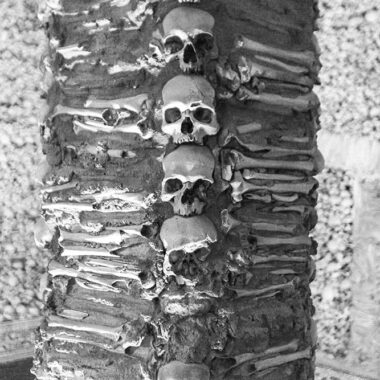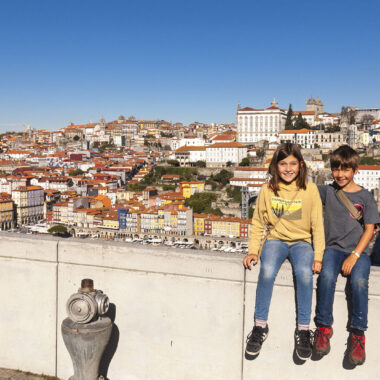Nazaré is very famous in the surfing world for the monstrous waves that pound its coastline a few times a year in the winter months. Both the male and female Guinness World Records for the largest waves ever surfed were set at Praia do Norte a short walk from the old town. We stayed in a wonderful apartment in the center of Nazaré’s old town, a stone’s throw from the beachfront promenade and sand of Praia da Nazaré. Since leaving The Algarve the temperatures started feeling much more like winter: instead of the 25°C/77°F maximums each day we were enjoying in southern Portugal we were lucky for the mercury to hit 18°C/64°F during our days in Nazaré. I busted out my down jacket for the first time since Alaska. Even with the cooler temperatures, Nazaré was a charming seaside village to explore for a few days, with a plethora of restaurants and bars lining the beachfront and cobblestoned streets of the old town. We all loved our time in town.
Get Directions
The seafood and Portuguese staple dishes like bifanas and soup were definitely a highlight for all of us, especially a night dining at O Santo de Anibal Portugal around the corner from our apartment. Restaurants around town weren’t consistently open every night given it was the off season when we visited, but we sniffed out O Santo de Anibal after watching where all the locals were walking for their evening meal. On offer were black clams, white clams, mussels in garlic broth, prawns or crab, all sold by weight and accompanied by a divine sweet potato and cabbage bisque as well as hot bread rolls. Simple food but so delicious and very much enjoyed by the four of us. We’ll all remember Nazaré as the place where Lilia and Max learned how to play pool late one evening in a pool bar, the kids pleading with us to teach them as we strolled home after dinner. Getting them ready for university good and early!
It was a 20 minute walk up the Ladeira do Sítio hiking trail from our apartment to the clifftops above Praia da Nazaré, some beautiful views of the town and coastline stretching south towards Lisbon along the way. The kids very much enjoyed riding on Baloiço da Ladeira, the famous swing along the walk that I have a feeling has been used in a lot of social media posts of the town. About the only souvenirs we’ve acquired on this trip of ours have been Christmas ornaments in each country, our ornament from Portugal was from a little old fella at the top of Ladeira do Sítio who was making wooden boats out of his basement (last photo below). It’ll be a good memory ofNazaré each Christmas when it gets hung on the tree.
Our visit toNazaré unfortunately didn’t coincide with any of the monster swells for which the town is famous. On our first day in town there were a a handful of surfers towing into the waves off the point of Praia do Norte, but the waves were only about nine to 12 feet. Great to watch, all the same. It’d be incredible to see the waves on a big day (I took a couple of photos of prints in the museum of waves on big days below). The surfing museum inside Forte de São Miguel Arcanjo at the southern end ofPraia do Norte – the spot where onlookers watch surfers when the swells are big – was very well done, with multiple halls filled with surfboards used at the break over the years. A very diverse quiver on show: everything from shortboards with steel weights and foot straps to towering Indo-style guns. Pretty special to see and touch the boards on which the male and female Guinness World Records were set for largest waves ever ridden.
The thousand year old Mosteiro de Alcobaça in the quaint town ofAlcobaça was a short drive from our digs inNazaré. The monastery was a behemoth structure, with a central cathedral flanked on either side by the monastery quarters. It was the first Gothic structure ever built in Portugal and is the largest church in the country. In its day it was one of the most important medieval monasteries in Portugal. It must have been such a hive of activity when it was full of monks, the dormitory (pictured about two thirds of the way down the gallery below) was massive and could have easily slept more than 100 people. The kitchen was very impressive as well: the gigantic chimney in its center was supported by eight steel pylons, and the kitchen basin was as big as a small swimming pool. A specially built aqueduct from the nearby River Alcoa was built to divert fresh water and fish into the kitchen basin for food preparation.
In the transept of the monastery’s church were tombs housing the 800-year-old corpses of King Pedro I and his mistress, Inês de Castro. Pedro’s father, King Afonso IV, orderedInês de Castro assassinated in retaliation for Pedro’s ongoing relationship her, which was forbidden by Alfonso. Pedro’s bloody revenge on the assassins became legendary: they were tortured for hours and eventually killed by having their hearts ripped out, one through his back and another through the chest! Five years afterInês de Castro’s death, Pedro had her body exhumed and dressed in the finest clothes and jewels, then placed on the throne as part of a coronation ceremony. He claimed he had secretly married his mistress prior to her death, the coronation ceremony of her corpse made her the only queen of Portugal crowned posthumously. After the ceremony, each noble, clergy member and peasant had to prove their loyalty by kissing the decomposing hand of their queen. The lovers lay a few feet from each other in fabulously intricate tombs that are some of the best works of Gothic sculpture in Portugal. Shakespeare couldn’t have written more enthralling fiction.Inês de Castro has remained a focus of fairytales and novels over the centuries, we even saw a Portuguese bestseller in the bookstores with her name as the title.
The pastelarias around Portugal have wowed us every time we’ve happened upon them for lunch: all function as traditional bakeries, and many of them supplement their delectable baked goods with hot sandwiches, soups and beer on tap. Pastelaria Doces da Carla across the square fromMosteiro de Alcobaça was an exceptional example (we were steered in its direction by the portly security guard at the monastery, who pointed to it when I asked him where he ate his lunch each day…). The huge bowls of traditional Portuguese vegetable soup for €1.50 were perfect for the cool weather, and their bifanas were delicious. The kids discovered coxinhas de frango atPastelaria Doces da Carla as well (and have been eating them at every chance they’ve had ever since): rotisserie chicken encapsulated in dough, molded into a teardrop, breaded and then deep fried. Not something that’s going to get a tick from the American Heart Association, but probably about the best combination of chicken and dough one could imagine. And the pastel de nata that have been a staple at pretty much every petrol station, convenience store and bakery in Portugal are hard not to chomp down at every opportunity. The flaky pastry cups filled with egg custard and burnt sugar on top, the perfect two bite snack at any time of day.







Further inland fromAlcobaça was another UNESCO World Heritage Listed monastery in Batalha. The gothic structure took almost 150 years to build and served to celebrate the triumph of the Portuguese over the Spanish (or Castilians back then…) in the battle of Aljubarrota in 1385. It was an incredible monument to take in from the outside, easily on par with the Catedral de Sevilla in Seville (but much easier to photograph given it was built with extensive surrounding gardens instead of in the middle of a city!). The intricacy of the stonework comprising the facade was mind boggling, to think how long it would have taken stonemasons to chip away over the years.
Mosteiro da Batalha’s interior was not as grandiose as neighboringMosteiro de Alcobaça, but the stunning Gothic stonework and beautiful stained glass throughout the church and Founder’s Chapel were incredible. The tombs of King João I and his family were quite magnificent, but no Shakespearean love stories to go along with them like that ofKing Pedro I and his mistress, Inês de Castro! The Tomb of the Unknown Soldier (pictured below with the Portuguese soldiers standing on either side) was a memorable exhibit as well: when I first walked into the cloister I thought the two female soldiers were wax mannequins, until one blinked as I was inspecting her up close and almost made me trip over my own feet as I backed up in fright! I was amazed she didn’t smile as she scared the willies out of me, some serious composure. Amazing they can stand there completely still for hours at a time.
Easily the most visually stunning of all the portions of the monasteries we visited in Leiria was As Capelas Imperfeitas (The Unfinished Chapels) on the eastern side of Mosteiro da Batalha. The octagonal rotunda was commissioned by King Duarte, the small addition to the main monastery took more than 70 years to finish. The labyrinthine stonework and central portal were amazing to see up close, with angels, ropes, circles and all manner of shapes extending up the walls to a height of more than 15 meters/50 feet. Truly a sight to behold.


























































































































Pingback: Sintra and Palácio Nacional da Pena - Our Walkabout Two
Pingback: The Douro Valley - Our Walkabout Two
Pingback: Budapest – The Pink Lemon